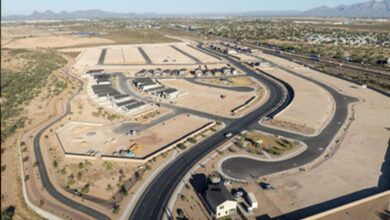
GUEST COLUMN: Three Factors Influencing the 2022 Real Estate Market in Tucson and Beyond
By Jack Clements
The COVID-19 pandemic hit the real estate market hard last year. From businesses who could no longer operate to multi-family tenants out of work, many in Tucson and across the U.S. were at risk of not being able to pay their rent at some point in 2020 or 2021.
However, the pandemic also brought opportunities for real estate owners and operators as many businesses were forced to reevaluate their operating structure and look for new spaces to adapt. To survive, some real estate owners and operators reinvented themselves in 2021, repurposing property to meet new market demands.
With a new year on the horizon, industry experts are evaluating what’s to come. For many, the news that the upcoming year looks to be more of the same challenges could be unsettling. However, real estate owners and operators hope to last year’s trends and the new tools they’ve accumulated to take as much control of their risk next year as possible.
Here are the top three factors influencing the real estate insurance market in Tucson and beyond that are expected to continue into 2022:
Catastrophic weather
Extreme natural catastrophes are no longer rare. Nearly one third of Americans live in a county impacted by a weather disaster in 2021.
The Washington Post, “Nearly 1 in 3 Americans experienced a weather disaster this summer,” September 4, 2021.
Due to its location and elevation, southern Arizona is often a target for extreme weather as well. In fact, a study out of the University of Arizona concluded that weather-related events have cost Arizona more than $3 billion since 2010 and that Tucson alone gets hit with about 47 extreme weather events per year.
Making Action Possible. “The Economic Impacts of Extreme Weather: Tucson and Southern Arizona’s Current Risks and Future Opportunities.” February 2, 2017.
Insurance carriers and property owners have taken notice, and this new attention to risk is causing many portfolio owners to evaluate property coverage costs and exclusions before purchasing coverage. As a result, reinsurers are exiting the market, drying up capacity and rates and consequently leaving fewer coverage options and higher rates for real estate owners and operators in the area.
While potentially unsettling, this market is projected to be the new normal as climate change continues to bring frequent and extreme storms to already high-risk regions.
In this environment, catastrophe models (CAT models) which simulate potential catastrophic events and estimate the potential loss will be more important. While old-fashioned, non-tech risk solutions and controls such as water mitigation and disaster recovery planning are still important to insurance carriers, CAT modeling will be critical in helping property owners understand the extent of their risk, estimate necessary policy limits and secure coverage accordingly. In fact, some underwriters are now requiring CAT modeling and other predictive tech for large portfolios.
Rising rates for the multi-family housing sector
Premiums for the multi-family sector for both property and liability insurance have increased more than any other real estate market, with rate increases surpassing anything the market has seen in the last decade.
Forbes. “Skyrocketing Property Insurance Costs: How to Mitigate Your Risks.” May 6, 2021.
The long-standing rise in the frequency of claims due to social inflation, incidents such as Florida’s Champlain Towers collapse and the new layer of unpredictability brought on by COVID-19 have all collided to create a challenging and sometimes impossible environment for property owners.
Unfortunately, there will be more scrutiny from carriers in 2022 as well. Underwriters will continue to put loss history, previous damage and updates to electrical, plumbing and roof structures under a microscope, and it’s estimated that rates will rise 20% or more in the habitational and residential real estate market overall.
To attract insurers, multi-family real estate owners will need to implement proper risk management measures and paint a detailed picture of control to underwriters. The more they can demonstrate that they have measures in place to prevent high-cost claims, the more likely they can secure competitive rates.
Vacancies
Losses and vacancies due to the impact of the COVID-19 pandemic on businesses large and small have brought new opportunities to every market. Luckily for real estate owners, the low interest rates that helped push repurposing along in 2021 are expected to remain relatively stable through the end of 2022.
Bloomberg, “Fed Likely Needs to Raise Interest Rates As Soon As Late 2022, IMF Says,” July 1, 2021.
Owners and operators eager to repurpose property need to remember that when a building’s purpose changes, so does its risk profile. Attention must be given in advance to the space’s existing infrastructure, the upgrades needed to suit the space’s new purpose and how these alterations will affect the asset’s property coverage.
When repurposing, there’s a good chance that some of the building’s systems infrastructure will need to be redesigned – inclusive of fire and life safety, mechanical, electrical, and plumbing systems.
Owners seeking to reduce their exposure and increase their portfolio’s resiliency will need to engage both new tech and traditional proactive controls in Tucson and beyond in 2022.
About the author
Jack Clements, CPA, CIC, is based in Tucson and is the President of Arizona Operations for global insurance brokerage Hub International. Jack joined HUB in 2020 as part of the Clements Insurance and HUB Southwest acquisition. He has been in the insurance industry since 1989 and manages a portfolio of challenging and complex cannabis, healthcare, real estate and construction accounts. He is a member of HUB Southwest’s Executive Management Team and heads the operations for Hub’s Arizona offices.





